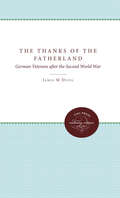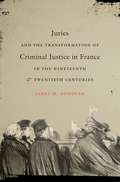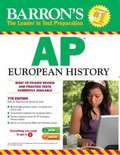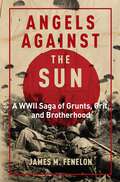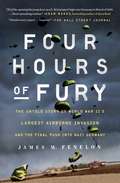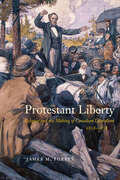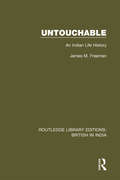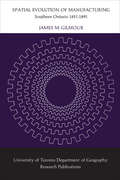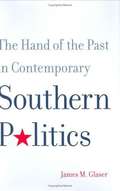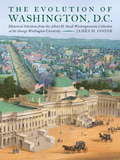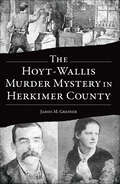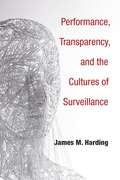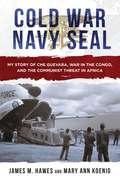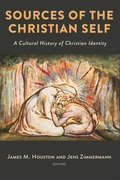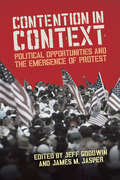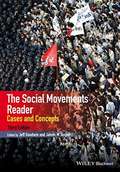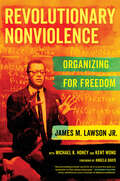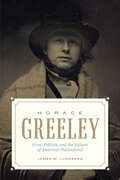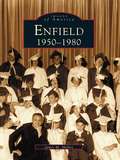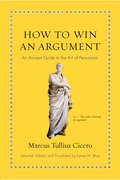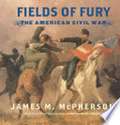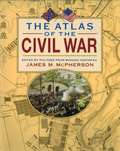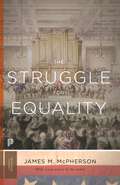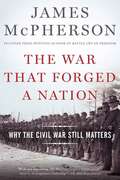- Table View
- List View
The Thanks of the Fatherland: German Veterans After the Second World War
by James M. DiehlAn account of the problems facing German veterans after WWII and the ways in which they were addressed in the decade following Germany's defeat. The primary focus is on the major pieces of veterans' legislation passed in the early years of the German Federal Republic. Historical context is provided by the first two chapters and the conclusion, which compares and contrasts the fate of veterans and their sociopolitical impact on German society following the two world wars.Originally published in 1993.A UNC Press Enduring Edition -- UNC Press Enduring Editions use the latest in digital technology to make available again books from our distinguished backlist that were previously out of print. These editions are published unaltered from the original, and are presented in affordable paperback formats, bringing readers both historical and cultural value.
Juries and the Transformation of Criminal Justice in France in the Nineteenth and Twentieth Centuries
by James M. DonovanJames Donovan takes a comprehensive approach to the history of the jury in modern France by investigating the legal, political, sociocultural, and intellectual aspects of jury trial from the Revolution through the twentieth century. He demonstrates that these juries, through their decisions, helped shape reform of the nation's criminal justice system.From their introduction in 1791 as an expression of the sovereignty of the people through the early 1900s, argues Donovan, juries often acted against the wishes of the political and judicial authorities, despite repeated governmental attempts to manipulate their composition. High acquittal rates for both political and nonpolitical crimes were in part due to juror resistance to the harsh and rigid punishments imposed by the Napoleonic Penal Code, Donovan explains. In response, legislators gradually enacted laws to lower penalties for certain crimes and to give jurors legal means to offer nuanced verdicts and to ameliorate punishments. Faced with persistently high acquittal rates, however, governments eventually took powers away from juries by withdrawing many cases from their purview and ultimately destroying the panels' independence in 1941.
Barron's AP European History (7th Edition)
by Seth A. Roberts James M. EderIn-depth preparation for the AP European History exam features: Two full-length model AP exams with all questions answered and explained A 15-chapter summary of European history for review, starting with Europe during the Italian Renaissance and progressing to Europe in the twenty-first century Essay questions and multiple-choice questions with answers following each chapter Extensive charts that summarize Europe's history The manual can be purchased alone or with an optional CD-ROM that presents two additional full-length practice tests with automatic scoring and fully explained answers. BONUS! An exclusive online exam included with the purchase of the book or the book with CD-ROM.
Angels Against the Sun: A WWII Saga of Grunts, Grit, and Brotherhood
by James M. FenelonIn the tradition of Band of Brothers, historian and former paratrooper James M. Fenelon offers a grunt&’s-eye view of the 11th Airborne&’s heroic campaign to liberate the Philippines in World War II. A soldier&’s history at its best.A Grunt&’s-Eye View of Pacific WarfareThe Pacific theater of World War II pitted American fighting men against two merciless enemies: the relentless Japanese army and the combined forces of monsoons, swamps, mud, privation, and disease. General Joseph Swing&’s rowdy paratroopers of the 11th Airborne Division— nicknamed the &“Angels&”—fought in some of the war&’s most dramatic campaigns, from bloody skirmishes in Leyte&’s unforgiving rainforests to the ferocious battles on Luzon, including the hellish urban combat of Manila. The Angels were trained as elite shock troops, but high American casualties often forced them into action as ground-pounding infantrymen. Surviving on airdropped supplies and reinforcements, the Angels fought their way across nearly impassable terrain, emerging as one of the most lethal units in the Pacific War. Their final task was the occupation of Japan, where they were the first American boots on the ground. Angels Against the Sun is an unforgettable account of the liberation of the Philippines. In the tradition of Band of Brothers, historian and former paratrooper James M. Fenelon offers a grunt&’s-eye view of the war. This is a soldier&’s history at its best.
Four Hours of Fury: The Untold Story of World War II's Largest Airborne Invasion and the Final Push into Nazi Germany
by James M. Fenelon&“Compellingly chronicles one of the least studied great episodes of World War II with power and authority…A riveting read&” (Donald L. Miller, New York Times bestselling author of Masters of the Air) about World War II&’s largest airborne operation—one that dropped 17,000 Allied paratroopers deep into the heart of Nazi Germany.On the morning of March 24, 1945, more than two thousand Allied aircraft droned through a cloudless sky toward Germany. Escorted by swarms of darting fighters, the armada of transport planes carried 17,000 troops to be dropped, via parachute and glider, on the far banks of the Rhine River. Four hours later, after what was the war&’s largest airdrop, all major objectives had been seized. The invasion smashed Germany&’s last line of defense and gutted Hitler&’s war machine; the war in Europe ended less than two months later. Four Hours of Fury follows the 17th Airborne Division as they prepare for Operation Varsity, a campaign that would rival Normandy in scale and become one of the most successful and important of the war. Even as the Third Reich began to implode, it was vital for Allied troops to have direct access into Germany to guarantee victory—the 17th Airborne secured that bridgehead over the River Rhine. And yet their story has until now been relegated to history&’s footnotes. In this viscerally exciting account, paratrooper-turned-historian James Fenelon &“details every aspect of the American 17th Airborne Division&’s role in Operation Varsity...inspired&” (The Wall Street Journal). Reminiscent of A Bridge Too Far and Masters of the Air, Four Hours of Fury does for the 17th Airborne what Band of Brothers did for the 101st. It is a captivating, action-packed tale of heroism and triumph spotlighting one of World War II&’s most under-chronicled and dangerous operations.
Protestant Liberty: Religion and the Making of Canadian Liberalism, 1828–1878 (McGill-Queen's Studies in the History of Religion)
by James M. ForbesTensions between Protestantism and Catholicism dominated politics in nineteenth-century Canada, occasionally erupting into violence. While some liberal politicians and community leaders believed that equal treatment of Protestants and Catholics would defuse these ancient quarrels, other Protestant liberals perceived a battle for the soul of the nation.Protestant Liberty offers a new interpretation of nineteenth-century liberalism by re-examining the role of religion in Canadian politics. While this era’s liberal thought is often characterized as being neutral toward religion, James Forbes argues that the origins of Canadian liberalism were firmly rooted in the British tradition of Protestantism and were based on the premise of guarding against the advance of supposedly illiberal faiths, especially Catholicism. After the union of Upper Canada with predominantly French-Catholic Lower Canada in 1840, this Protestant ideal of liberty came into conflict with a more neutral alternative that sought to strip liberalism of its religious associations in order to appeal to Catholic voters and allies. In a decisive break from their Protestant heritage, these liberals redefined their ideology in secular-materialist terms by emphasizing free trade and private property over faith and culture.In tracing how the Confederation generation competed to establish a unifying vision for the nation, Protestant Liberty reveals religion and religious differences at the centre of this story.
Untouchable: An Indian Life History (Routledge Library Editions: British in India #25)
by James M. FreemanNearly 16% of India’s population – or over 100 million people – are untouchables. Most of them, despite decades of government efforts to improve their economic and social position, remain desperately poor, illiterate, subject to brutal discrimination and economic exploitation, and with no prospect for improvement of their condition. This is the autobiography, first published in 1979, of Muli, a 40-year-old untouchable of the Bauri caste, living in the Indian state of Orissa, as told to an American anthropologist. Muli is a narrator who combines rich descriptions of daily life with perceptive observations of his social surroundings. He describes with absorbing detail what it is like to be at the bottom of Indian life, and what happens when an untouchable attempts to break out of his accepted role.
Spatial Evolution of Manufacturing: Southern Ontario 1851-1891
by James M. GilmourEuropeans who settled previously unpopulated and unexploited regions of the world during the 18th and 19th centuries of the world had two economic alternatives: subsistence activities or the production of primary goods for export. In general the latter prevailed and the landscape and economy were transformed. This study examines industrial growth in Southern Ontario, one of the most economically successful regions, from 1851-1891, a period when primary activities were still very important but also when today's industrial structure was clearly being shaped. Economists, geographers, and those in related fields will welcome this approach which unites regional economic growth theory, and an empirical examination of distributional and structural change in manufacturing, in a general explanation of the spatial development of manufacturing that is relevant to all export-based regions.
The Hand of the Past in Contemporary Southern Politics
by James M. GlaserA central story of contemporary southern politics is the emergence of Republican majorities in the region's congressional delegation. Acknowledging the significance and scope of the political change, James M. Glaser argues that, nevertheless, strands of continuity affect the practice of campaign politics in important ways. Strong southern tradition underlies the strategies pursued by the candidates, their presentational styles, and the psychology of their campaigns. The author offers eyewitness accounts of recent congressional campaigns in Texas, Mississippi, Virginia, North Carolina, and South Carolina. In the tradition of his award-winning book Race, Campaign Politics, and the Realignment in the South,Glaser captures the "stuff" of politics--the characters, the images, the rhetoric, and the scenery. Painting a full and fascinating picture of what it is like on the campaign trail, Glaser provides wide-ranging insights into the ways that the "hand of the past" reaches into the southern present.
The Evolution of Washington, DC
by Sandra Day O'Connor John Wetenhall James M. Goode Laura W. Bush Steven KnappThe Evolution of Washington, DC is a striking volume featuring select pieces of the extraordinary collection of Washingtoniana donated by Albert H. Small to the George Washington University in 2011. It showcases treasures such as an 1860 lithograph of the equestrian statue of Andrew Jackson in front of the White House and a contemporary print of old Potomac River steamboats. Other unique pieces include early designs for the White House, the Capitol, and the Washington Monument as well as presidential portraits and Civil War memorabilia. Each object--from architectural plans and topographical maps to letters and advertisements--tells a fascinating story, and together they illustrate the history of our nation's capital and indeed our nation itself.
The Hoyt-Wallis Murder Mystery in Herkimer County (True Crime)
by James M. GreinerWarren township in the southern portion of Herkimer County has been the scene of more than one gruesome event. In January 1885, locals reeled in horror when disgruntled wife Roxalana Druse shot her husband and dismembered his corpse to incinerate it in a farm house stove. Her trial and hanging was followed up in May of 1901 with two murders in yet another farm house kitchen. John C. Wallis had allowed his ex-wife Arvilla to return home, one year after running off with hired farm hand Ben Hoyt. Wallis then rehired Hoyt and within months both Ben Hoyt and Arvilla Wallis were dead. Did Ben Hoyt murder Arvilla in cold blood or did John C. Wallis kill both of them? Author James M. Greiner investigates a mysterious case of marriage, infidelity and multiple murders in turn of the century Herkimer County.
Performance, Transparency, and the Cultures of Surveillance
by James M. HardingPlacing the disciplines of performance studies and surveillance studies in a timely critical dialogue, Performance, Transparency, and the Cultures of Surveillance not only theorizes how surveillance performs but also how the technologies and corresponding cultures of surveillance alter the performance of everyday life. This exploration draws upon a rich array of examples from theatre, performance, and the arts, all of which provide vivid illustration of the book’s central argument: that the rise of the surveillance society coincides with a profound collapse of democratic oversight and transparency—a collapse that, in turn, demands a radical rethinking of how performance practitioners conceptualize art and its political efficacy. The book thus makes the case that artists and critics must reexamine—indeed, must radically redefine—their notions of performance if they are to mount any meaningful counter to the increasingly invasive surveillance society.
Cold War Navy SEAL: My Story of Che Guevara, War in the Congo, and the Communist Threat in Africa
by James M. Hawes Mary Ann KoenigFor the first time, a Navy SEAL tells the story of the US's clandestine operations in North Vietnam and the Congo during the Cold War. Sometime in 1965, James Hawes landed in the Congo with cash stuffed in his socks, morphine in his bag, and a basic understanding of his mission: recruit a mercenary navy and suppress the Soviet- and Chinese-backed rebels engaged in guerilla movements against a pro-Western government. He knew the United States must preserve deniability, so he would be abandoned in any life-threatening situation; he did not know that Che Guevara attempting to export his revolution a few miles away. Cold War Navy SEAL gives unprecedented insight into a clandestine chapter in US history through the experiences of Hawes, a distinguished Navy frogman and later a CIA contractor. His journey began as an officer in the newly-formed SEAL Team 2, which then led him to Vietnam in 1964 to train hit-and-run boat teams who ran clandestine raids into North Vietnam. Those raids directly instigated the Gulf of Tonkin Incident. The CIA tapped Hawes to deploy to the Congo, where he would be tasked with creating and leading a paramilitary navy on Lake Tanganyika to disrupt guerilla action in the country. According to the US government, he did not, and could not, exist; he was on his own, 1400 miles from his closest allies, with only periodic letters via air-drop as communication. Hawes recalls recruiting and managing some of the most dangerous mercenaries in Africa, battling rebels with a crew of anti-Castro Cuban exiles, and learning what the rest of the intelligence world was dying to know: the location of Che Guevara. In vivid detail that rivals any action movie, Hawes describes how he and his team discovered Guevara leading the communist rebels on the other side and eventually forced him from the country, accomplishing a seemingly impossible mission. Complete with never-before-seen photographs and interviews with fellow operatives in the Congo, Cold War Navy SEAL is an unblinking look at a portion of Cold War history never before told.
Sources of the Christian Self: A Cultural History of Christian Identity
by James M. Houston, Jens ZimmermannUsing Charles Taylor&’s magisterial Sources of the Self: The Making of the Modern Identity as a springboard, this interdisciplinary book explores lived Christian identity through the ages. Beginning with such Old Testament figures as Abraham, Moses, and David and moving through the New Testament, the early church, the Middle Ages, and onward, the forty-two biographical chapters in Sources of the Christian Self illustrate how believers historically have defined their selfhood based on their relation to God/Jesus. Among the many historical subjects are Justin Martyr, Origen, Augustine, Aquinas, Julian of Norwich, Dante, John Calvin, Teresa of Ávila, John Bunyan, Jonathan Edwards, Christina Rossetti, Blaise Pascal, Søren Kierkegaard, C. S. Lewis, and Flannery O&’Connor—all of whom boldly lived out their Christian identities in their varied cultural contexts. In showing how Christian identity has evolved over time, Sources of the Christian Self offers deep insight into our own Christian selves today.CONTRIBUTORS: Markus Bockmuehl Keith Bodner Gerald P. Boersma Hans Boersma Robert H. Bork Paul C. Burns Julie Canlis Victor I. Ezigbo Craig M. Gay Yonghua Ge Christopher Hall Ross Hastings Bruce Hindmarsh James M. Houston Sharon Jebb Smith Robert A. Kitchen Marian Kamell Kovalishyn Pak-Wah Lai Jay Langdale Bo Karen Lee Jonathan Sing-cheung Li V. Phillips Long Howard Louthan Elizabeth Ludlow Eleanor McCullough Stephen Ney Ryan S. Olson Steve L. Porter Iain Provan Murray Rae Jonathan Reimer Ronald T. Rittgers Sven Soderlund Janet Martin Soskice Mikael Tellbe Colin Thompson Bruce K. Waltke Steven Watts Robyn Wrigley-Carr Jens Zimmermann
Contention in Context
by Jeff Goodwin James M. JasperDespite extensive theoretical debates over the utility of "political opportunities" as an explanation for the rise and success of social movements, there have been surprisingly few serious empirical tests. Contention in Context provides the most extensive effort to date to test the model, analyzing a range of important cases of revolutions and protest movements to identify the role of political opportunities in the rise of political contention. With evidence from more than fifty cases, this book explores the role of the state in protest, the frequent overemphasis on political opportunities in recent research, and the extent to which opportunity models ignore the cultural and emotional triggers for collective action. By examining new directions in the study of protest and contention, this book shows that although political opportunities can help explain the emergence of certain kinds of movements, a new strategic language can ultimately tell us far more.
The Social Movements Reader: Cases and Concepts Third Edition
by Jeff Goodwin James M. JasperProviding a unique blend of cases, concepts, and essential readings The Social Movements Reader, Third Edition, delivers key classic and contemporary articles and book selections from around the world. Includes the latest research on contemporary movements in the US and abroad, including the Arab spring, Occupy, and the global justice movement. Provides original texts, many of them classics in the field, which have been edited for the non-technical reader. Combines the strengths of a reader and a textbook with selected readings and extensive editorial material.
My Declaration Of Independence
by James M. JeffordsSenator James Jeffords of Vermont left the Republican Party on May 24, 2001, when he could no longer reconcile his beliefs with the policies of the party he had supported his whole Ault life."Looking ahead," Jeffords said, "I can see more and more instances where I will disagree with the President on very fundamental issues." In My Declaration of Independence, Jeffords explains the issues that led to this dramatic break. Foremost among them was the Bush administration's and the Republican leadership's failure to recognize the need to invest in education, now and in the future. Tracing the genesis of his decision, Jeffords describes his attempts to effect change within its party, and the pain of hurting Republican colleagues and friends. His decision came just at he moment when his defection would deprive them of the Washington trifects they had recently achieved-Republican control of the White House, the Senate, and the House of representatives. It was also going to cost many of his friends committee chairmanships they had acquired only a few months before. "But in he end," he writes, "I had to be true to what I hought was right, and leave the consequences to sort themselves out in the days ahead." In a contemporary Profiles in Courage, Senator Jeffords provides a moving, witty, and instructive example of what can happen in public life. Whether you agree with his views or not, his account of his tough decisions, and of his anguish at rejecting the last-minute appeals of the leadership of his party, the President, and his wife, is a riveting story that has wide implications for the whole country.
Revolutionary Nonviolence: Organizing for Freedom
by James M. Lawson JrA persuasive account of the philosophy and power of nonviolence organizing, and a resource for building and sustaining effective social movements. Despite the rich history of nonviolent philosophy, many people today are unfamiliar with the basic principles and practices of nonviolence––even as these concepts have guided so many direct-action movements to overturn forms of racial apartheid, military and police violence, and dictatorships around the world. Revolutionary Nonviolence is a crucial resource on the long history of nonviolent philosophy through the teachings of Rev. James M. Lawson Jr., one of the great practitioners of revolution through deliberate and sustained nonviolence. His ongoing work demonstrates how we can overcome violence and oppression through organized direct action, presenting a powerful roadmap for a new generation of activists. Rev. Lawson’s work as a theologian, pastor, and social-change activist has inspired hope and liberation for more than sixty years. To hear and see him speak is to experience the power of the prophetic tradition in the African American and social gospel. In Revolutionary Nonviolence, Michael K. Honey and Kent Wong reflect on Rev. Lawson's talks and dialogues, from his speeches at the Nashville sit-in movement in 1960 to his lectures in the current UCLA curriculum. This volume provides a comprehensive introduction to Rev. Lawson's teachings on how to center nonviolence in successfully organizing for change.
Horace Greeley: Print, Politics, and the Failure of American Nationhood
by James M. LundbergA lively portrait of Horace Greeley, one of the nineteenth century's most fascinating public figures.The founder and editor of the New-York Tribune, Horace Greeley was the most significant—and polarizing—American journalist of the nineteenth century. To the farmers and tradesmen of the rural North, the Tribune was akin to holy writ. To just about everyone else—Democrats, southerners, and a good many Whig and Republican political allies—Greeley was a shape-shifting menace: an abolitionist fanatic; a disappointing conservative; a terrible liar; a power-hungry megalomaniac.In Horace Greeley, James M. Lundberg revisits this long-misunderstood figure, known mostly for his wild inconsistencies and irrepressible political ambitions. Charting Greeley's rise and eventual fall, Lundberg mines an extensive newspaper archive to place Greeley and his Tribune at the center of the struggle to realize an elusive American national consensus in a tumultuous age. Emerging from the jangling culture and politics of Jacksonian America, Lundberg writes, Greeley sought to define a mode of journalism that could uplift the citizenry and unite the nation. But in the decades before the Civil War, he found slavery and the crisis of American expansion standing in the way of his vision. Speaking for the anti-slavery North and emerging Republican Party, Greeley rose to the height of his powers in the 1850s—but as a voice of sectional conflict, not national unity. By turns a war hawk and peace-seeker, champion of emancipation and sentimental reconciliationist, Greeley never quite had the measure of the world wrought by the Civil War. His 1872 run for president on a platform of reunion and amnesty toward the South made him a laughingstock—albeit one who ultimately laid the groundwork for national reconciliation and the betrayal of the Civil War's emancipatory promise.Lively and engaging, Lundberg reanimates this towering figure for modern readers. Tracing Greeley's twists and turns, this book tells a larger story about print, politics, and the failures of American nationalism in the nineteenth century.
Enfield: 1950-1980
by James M. MalleyIn the past half-century, Enfield has undergone a transformation from a rural mill-and-farming town of fifteen thousand to a substantial suburban community of forty-five thousand. Located in the north central part of the state on the eastern side of the Connecticut River, the town once known as the Carpet City began to change when the carpet industry moved parts of its operation south and Interstate 91 was built, bringing in new businesses and new residents.Enfield: 1950-1980 traces the changing landscape of Thompsonville, Enfield, and North Thompsonville through the carpet-making days to the town's recent past. Exceptional photographs depict major highway construction and the development of the regional mall district, the destructive forces of the 1955 flood and of fires throughout the years, and the unique leaders, businesses, and events that have shaped the town of today.
How to Win an Argument: An Ancient Guide to the Art of Persuasion
by Marcus Tullius Cicero James M. MayAll of us are faced countless times with the challenge of persuading others, whether we're trying to win a trivial argument with a friend or convince our coworkers about an important decision. Instead of relying on untrained instinct--and often floundering or failing as a result--we'd win more arguments if we learned the timeless art of verbal persuasion, rhetoric. How to Win an Argument gathers the rhetorical wisdom of Cicero, ancient Rome's greatest orator, from across his works and combines it with passages from his legal and political speeches to show his powerful techniques in action. The result is an enlightening and entertaining practical introduction to the secrets of persuasive speaking and writing--including strategies that are just as effective in today's offices, schools, courts, and political debates as they were in the Roman forum.How to Win an Argument addresses proof based on rational argumentation, character, and emotion; the parts of a speech; the plain, middle, and grand styles; how to persuade no matter what audience or circumstances you face; and more. Cicero's words are presented in lively translations, with illuminating introductions; the book also features a brief biography of Cicero, a glossary, suggestions for further reading, and an appendix of the original Latin texts.Astonishingly relevant, this unique anthology of Cicero's rhetorical and oratorical wisdom will be enjoyed by anyone who ever needs to win arguments and influence people--in other words, all of us.
Fields Of Fury: The American Civil War
by James M. McPhersonPulitzer Prize award-winning historian James M. McPherson has written for young readers a stirring account of the greatest conflict to happen on our nation's soil, the Civil War, bringing to life the tragic struggle that divided not only a nation, but also friends and family. <p><p> From the initial Confederate attack on Fort Sumter, to the devastating loss of life at Shiloh as Ulysses S. Grant led the Union to unexpected victory, to the brilliance of Stonewall Jackson's campaign at Shenandoah, to General Pickett's famous charge at Gettysburg, to the Union's triumph at Appo-mattox Court House, Fields of Fury details the war that helped shape us as a nation. Also included are personal anecdotes from the soldiers at the battlefront and the civilians at home, as well as profiles of historical luminaries such as Robert E. Lee, Abraham Lincoln, Jefferson Davis, and Ulysses S. Grant. McPherson also explores the varied roles that women played during the war, healthcare on the battlefield, and the demise of slavery. McPherson's narrative is highlighted with black-and-white photographs taken by Civil War photographers Mathew Brady and Timothy O'Sullivan, period oil paintings, and key campaign and battlefield maps, that make Fields of Fury the consummate book on the American Civil War for kids.
The Atlas of the Civil War
by James M. McPhersonFrom the first shots fired at Fort Sumter in 1861 to the final clashes on the Road to Appomattox in 1864, The Atlas of the Civil War reconstructs the battles of America's bloodiest war with unparalleled clarity and precision. Edited by Pulitzer Prize recipient James M. McPherson and written by America's leading military historians, this peerless reference charts the major campaigns and skirmishes of the Civil War. Each battle is meticulously plotted on one of 200 specially commissioned full-color maps. Timelines provide detailed, play-by-play maneuvers, and the accompanying text highlights the strategic aims and tactical considerations of the men in charge. Each of the battle, communications, and locator maps are cross-referenced to provide a comprehensive overview of the fighting as it swept across the country. With more than two hundred photographs and countless personal accounts that vividly describe the experiences of soldiers in the fields, The Atlas of the Civil War brings to life the human drama that pitted state against state and brother against brother.
The Struggle for Equality: Abolitionists and the Negro in the Civil War and Reconstruction - Updated Edition (Princeton Classics #12)
by James M. McPhersonOriginally published in 1964, The Struggle for Equality presents an incisive and vivid look at the abolitionist movement and the legal basis it provided to the civil rights movement of the 1960s. Pulitzer Prize–winning historian James McPherson explores the role played by rights activists during and after the Civil War, and their evolution from despised fanatics into influential spokespersons for the radical wing of the Republican Party. Asserting that it was not the abolitionists who failed to instill principles of equality, but rather the American people who refused to follow their leadership, McPherson raises questions about the obstacles that have long hindered American reform movements.This new Princeton Classics edition marks the fiftieth anniversary of the book's initial publication and includes a new preface by the author.
The War That Forged A Nation: Why The Civil War Still Matters
by James M. McPhersonMore than 140 years ago, Mark Twain observed that the Civil War had "uprooted institutions that were centuries old, changed the politics of a people, transformed the social life of half the country, and wrought so profoundly upon the entire national character that the influence cannot be measured short of two or three generations." In fact, five generations have passed, and Americans are still trying to measure the influence of the immense fratricidal conflict that nearly tore the nation apart. In The War that Forged a Nation, Pulitzer Prize-winning historian James M. McPherson considers why the Civil War remains so deeply embedded in our national psyche and identity. The drama and tragedy of the war, from its scope and size--an estimated death toll of 750,000, far more than the rest of the country's wars combined--to the nearly mythical individuals involved--Abraham Lincoln, Robert E. Lee, Stonewall Jackson--help explain why the Civil War remains a topic of interest. But the legacy of the war extends far beyond historical interest or scholarly attention. Here, McPherson draws upon his work over the past fifty years to illuminate the war's continuing resonance across many dimensions of American life. Touching upon themes that include the war's causes and consequences; the naval war; slavery and its abolition; and Lincoln as commander in chief, McPherson ultimately proves the impossibility of understanding the issues of our own time unless we first understand their roots in the era of the Civil War. From racial inequality and conflict between the North and South to questions of state sovereignty or the role of government in social change--these issues, McPherson shows, are as salient and controversial today as they were in the 1860s. Thoughtful, provocative, and authoritative, The War that Forged a Nation looks anew at the reasons America's civil war has remained a subject of intense interest for the past century and a half, affirms the enduring relevance of the conflict for America today.
